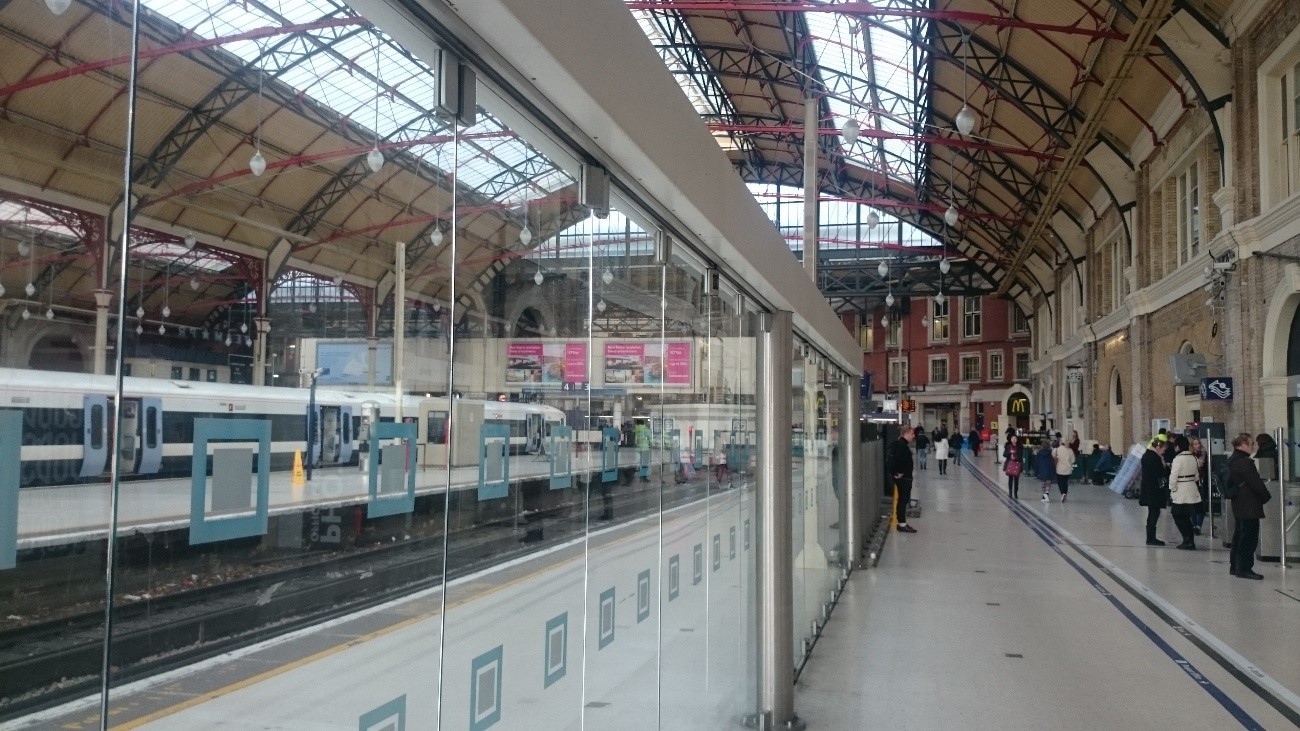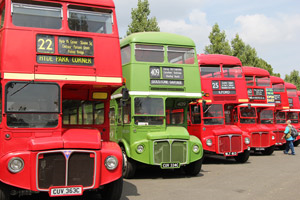リスク対応策 2020.02.17
RM 12 ルートマスター(ロンドンバス)Routemaster (London Bus)
目次
For those who prefer to read this column in English, the Japanese text is followed by a British English translation, so please scroll down to the bottom of the Japanese text.
昨年、2019年11月29日午後、ロンドン中心部ロンドン・ブリッジで、刃物を持った男が通行人に切りつけ2人が亡くなり、3人が負傷した。英国警察は「テロ事件」と断定した。金融街シティに近い現場では、2017年にも別のテロ事件が起き、その昔「2012年夏季オリンピック」の開催地にロンドンが決まった翌日、2005年7月7日もロンドンで同時爆破テロ事件が起きた。地下鉄の3か所がほぼ同時に、またその約1時間後に「監視カメラ付きの最新鋭の2階建てバス」も爆破され、合わせて56人の尊い命を奪った。
北アイルランド紛争で過激を極めたIRA(アイルランド共和軍)のテロ行為が収まって、この30年、「テロとは無縁」と思えたロンドンでテロが起き続けている。さらに、「EU離脱」後、アイルランドと北アイルランド間の国境管理が再開されれば、過激派の武装闘争が再燃するのではないかという懸念が取り沙汰されている。

1.地下鉄駅の改修工事
ロンドンの地下鉄は「チューブ」と呼ばれている。市の中央を横切る路線がセントラルライン、ロンドンの西側にある駅の一つに「クイーンズウエイ」がある。
18世紀、園芸が趣味の時の王妃が大拡張を行い、隣接するハイドパークと地続きとなってしまったケンジントン宮殿の庭園、ケンジントンガーデン。そこから、通り一つ隔てたところにその駅はある。ロンドンで同時爆破テロ事件が起きた2005年、その5月改修工事に入った。折からロンドン出張中で、「あの中華料理屋に行ってみよう」と地下鉄に乗ろうと駅に行ったら「改修工事」の掲示があった。
日本であれば、乗降客の不便にならないように改修は一部分ずつ行なっていくのが普通である。しかし、ロンドンは驚かされる街だ。駅全体を閉鎖する。しかもその改修期間たるや、1年間。全て閉鎖、翌年5月までその駅は全く使えない。「地下鉄に乗りたい人は、1年間は近くの駅まで歩くか別の線に乗りなさい」ということである。
その後も、実に頻繁に路線の補修工事が行なわれている。行くたびにどこかしらで地下鉄の駅の改修工事をおこなっているのがロンドンである。一昨年から昨年に掛け、定宿の下にある地下鉄の駅「ランカスターゲート」が、やはり「1年間使用止め」で改修工事をおこなっていた。
したがって、補修箇所にあたる駅は当然通過する、一定区間を閉鎖して「手前で折り返し」ということもある。ストでもよく止まる。地下鉄は都市の大動脈と言われるが、ロンドンではそうとも言えない日の方が多い。その代わりに大きく機能しているのがバスである。「通りの見える範囲に10台以上のバス」ということもざらである。慣れると地下鉄以上に便利な交通手段である。

2.ロンドン・バス(ルートマスター)
地下鉄に乗るには、当然のことだが地下に降りなければならない。日本のようにエスカレーターが敷設されている駅も多いが、多くの駅には大きなエレベーターがありこれを使って地上と地下の行き来をする人も多い。地下に降りるのにエレベーターを待つ、地上に上がるのにまた待つ。この繰り返しは、荷物を持つ手には応える。バスにはその必要がない。ラッシュアワーの時間帯を外せば実にスムーズな移動を可能にする交通手段である。
車体を赤く塗った2階建ては「ロンドン・バス」として有名である。なかでも、後ろの乗降口にドアがなく原則はバス停だけだがどこでも乗り降りが自由にできる、そんな車掌が乗っているバスは「ルートマスター」と呼ばれている。長年ロンドンの名物となってきたが、2005年12月9日、最後の市内159番ルートからルートマスターが姿を消し、引退した。しかし、ロンドンの人達にも、数多くの観光客にも愛されてきたルートマスターを「完全に引退させるのは忍びない」と2つの観光ルートに限って復活した。古いものを大切にするイギリスらしい粋な計らいである。
ロンドン・バスは、別名「ダブルデッカー」とも呼ばれる。床板(デッキ)が1階と2階、2つあるからである。早いスピードでカーブをきると重心が高くサスペンションが悪いため傾く。ロンドンの街を歩くと実に多くの通りが緩やかなカーブを描いているのが解る。直線が少なく曲線が多い道路。これは交通手段が馬車を基幹としたことによる。馬車がスピードを緩めずに目的地まで最も早くたどり着く方法、それはスピードを落とさずに走れる曲線道路を多く造ることであった。自動車を主体とした直線的な道路造りとの根幹思想の違いである。
ロンドン・バスは、19世紀初めフランスから乗合馬車「オムニバス」を輸入したことが起源である。庶民のための交通手段であるため低料金でなければならず、コスト圧縮のためできるだけ多くの乗客を乗せようとして馬車の屋根の上を利用したことが2階建ての始まりである。馬車からバスへ。ロンドンを走っていたトラム、トローリー・バスがすべて撤去され、替わりに1954年ルートマスターが導入された。
ルートマスター廃止の主な理由は、後部ステップの乗車口にドアがなく危険で車椅子での乗り降りもできない、「EUが定める安全基準を満たしていない」というものであった。しかし、存続を求めるルートマスター協会は「後部ステップから落ちる事故は年間2~3件ほどであり早急な対応が必要という事態ではない。車椅子での利用が可能な数は既に運行している。車掌が乗車しているため、運転手が切符の確認で停車する必要もなくそのための渋滞を発生させることはない、また犯罪発生の抑制効果もある」と主張してきた。
3.新たなリスクの創出
なぜ、「ルートマスター」の廃止が急速に進んだのだろうか。共通通貨ユーロが使われるなか、英国はポンドを使い続けている。だから「可能なものはEUとの統合を進展させようとする政策判断」をしたためであった。ロンドン市交通局は、EUが全加盟国に求めている「すべての人に利用可能なバス、サービスの提供」を2013年に実施した。確かにバリア・フリーを進めることは大切なことだ。しかし、補助者なく果たしてどれほどの車椅子の人がバスを利用することができるのだろうか。新型バスには車掌は乗車していない。運転手はハンドルを握り続けなければいけない。自分で車椅子を押して乗り込むのである。何百回と私はバスを利用してきたが一度も車椅子の人が乗り込んでくるのを見たことがない。
むしろ遅れを取り戻すためか、運転は荒くスピードも格段に速いと感じた。新しいイレモノは創った。だがそれが「求めるべきもの」になっていたのだろうか。2005年の爆弾テロで標的になったのは、新型の2階建てバスであった。いまの主要課題はテロ対策である。「人間の眼」の果たす役割、抑止効果は大きい。
「監視カメラ」は縦横無尽に張り巡らされている、しかしそれが役立つのは往々にして事件が起きてからである。「一つの目的が達せられた場合、他の目的達成度合いは減少すること」が実は多い、レトロなルートマスターから新型バスになってリスクマネジメントの点では劣化したと言えないだろうか。「新しいリスク」が創出され、その対策が新たに必要になったからである。
しかし、今年1月EUからの離脱が正式に決定、観光の目玉づくりに、またルートマスターが大きく復活する可能性も出てきた、そうなれば、「レトロなリスクマネジメント手段」である「人間の眼」がまた活きることになるだろう。
4.リスクマネージャーの委任
このように、リスクマネジメントの分野では「リスクとの追いかけっこ」が日常茶飯事である。だから、継続的にリスクの対応策の検討と検証が必要なのである。そのためには、専門部署、そしてその専門部署を率いる「リスクマネ-ジャー」の存在が必要である。
しかし、そのような専門人材は日本には多くいない。背景としては、リスクマネージャーが育つ環境が整えられていないからである。欧米では「一旦得た専門知識を活かして転職することはごく一般的」である。だが、転職すること、人の数、どちらも増えているが、まだまだまったく欧米の比ではない。転職市場が限られていることがその理由の1つである。
また、リスクマネージャーを生み出すインキュベーター(孵卵器)は保険会社であるが、「定期人事異動」が一般的ではない欧米と違い、日本には存在する。このため、「専門人材」が育ちにくい環境にある。
欧米の保険会社に入社した、例えば火災保険部門に配属された人はそこで専門的なスキルを学ぶことができ、かつその仕事が自分の性に合えば、もし保険会社、保険関係の会社で一生仕事をする場合、火災保険に従事する人が大半である。そうやって「専門スキル」を身につけ自分のキャリアアップを目指す。だから、専門人材である「リスクマネージャー候補」は市場に多く存在するのである。
しかし、日本では定期人事異動のため「ゼネラリスト」は多く育成されるが、リスクマネージャーのような「スペシャリスト」は、多くは存在しない。このため、保険、リスクマネジメント分野の専門人材であるリスクマネージャーの育成は、一般的な企業では大変困難な状況である。
今回のまとめ
このような状況へのソリューションとして、グローバル・リンクでは、「キャプティブ設立、運営管理コンサルティング」以外の事業として、企業とリスクマネジメント契約を締結して「企業のリスクマネージャーの委任を受ける事業」をもう一つの事業の柱としておこなっており、ご好評をいただいている。
「『マニュアル』に書いてあるような単純なリスクマネジメント」であれば、誰でも実行できるが、「そのリスクマネジメントを実態に即したものとして、運用、そして常にイノベーションしていくためには、相当な専門知識を必要とするから」である。
キャプティブの設立メリットを拡大する継続的なリスクマネジメントは、企業経営の安定性と収益拡大のためには重要な企業戦略の一つである。
ITの進展によって、時代が、事業環境が大きく変化するいま、企業経営、収益拡大にも大きく資する、キャプティブ設立を視野に入れた本格的なリスクマネジメントを始めてみたらいかがだろうか。
執筆・翻訳者:羽谷 信一郎
English Translation
Risk Management 12 Routemaster (London Bus)
Last year, two people were killed and three others injured when a man with a knife slashed at passersby in London Bridge, central London, on the afternoon of November 29, 2019. British police have ruled it a “terrorist incident”. Another terrorist attack took place in 2017 at a site near the financial district of the City, and another simultaneous bombing took place in London on July 7, 2005, a day after London was chosen to host the “2012 Summer Olympics” a long time ago. Three subway stations were blown up at about the same time, and about an hour later a “state-of-the-art double-decker bus with surveillance cameras” was also blown up, claiming a total of 56 lives.
Thirty years after the IRA’s terrorism, which reached its peak during the conflict in Northern Ireland, has subsided, terrorism has continued to occur in London, a city that seemed to be “terror-free” for the past 30 years. Furthermore, there are concerns that the reintroduction of border controls between Ireland and Northern Ireland after exiting from the EU could reignite the armed struggle of extremists.
1. Subway station renovations
The London Underground is known as the “Tube”. One of the stations on the west side of the city, on the Central Line, is Queensway, the garden of Kensington Palace, Kensington Gardens, which was enlarged in the 18th century by the Queen during her horticultural hobby and became part of the adjacent Hyde Park.
The station is just across the street from it. In May 2005, when the terrorist attacks on London took place, the station was undergoing renovation. I was on a business trip to London at the time, and when I went to the station to take the subway to “go to that Chinese restaurant”, I found a signboard saying that the station was under renovation.
In Japan, it is usual that renovation work is done one part at a time to avoid inconvenience for passengers. However, London is an amazing city. The whole station will be closed down. And the refurbishment will last for one year. It will be closed and the station will be completely unusable until May of the following year. It is “If you want to take the Tube, you should walk to the nearest station or take another line for a year”.
Since then, there have been many repair works on the subway lines. In London, every time I go there, they carry out renovation of subway stations somewhere. Between the year before last and the year after last, the tube station under my hotel, Lancaster Gate, was also undergoing repair work for a year.
Therefore, stations that fall in the repair area will naturally pass through, and sometimes they will close a certain section and “turn around in front of it”. The train often stops on strike. It is said that the subway is the main artery of the city, but in London, it is not so much the case on many days. Instead, it is the buses that largely function. It’s not unusual to see “more than 10 buses within sight of the street”. Once you get used to it, it’s even more convenient than the Tube.
2 London Buses (Routemaster)
When you take the subway, you have to go down to the basement, of course. There are many stations with escalators like Japan, but there are many people who go back and forth between the ground and the basement using a big elevator in many stations. You have to wait for the elevator to go down to the basement, and then wait again to go up to the ground. This repetition responds to the hands holding the luggage. The bus doesn’t have to. Outside of rush hour, it is a really smooth way to get around.
The double-decker buses with their red painted bodies are known as the “London Buses”. They have no doors at the rear of the bus, and although they are generally confined to bus stops, they are known as ‘Routemasters’, because they have conductors that allow passengers to get on and off at will. They have been a London institution for many years, but on December 9, 2005, the Routemaster disappeared from the city’s 159th route, the last of which was retired. However, the Route Master, beloved by Londoners and tourists alike, was brought back to life on two tourist routes because “it was unbearable to retire him completely”. It’s a nifty move that is typical of Britain, which values the old.
The London bus is also known as a “double-decker”. This is because they have two decks, one on the first floor and one on the second floor. If you take a curve at high speed, the bus will tilt due to its high center of gravity and poor suspension. If you walk around London, you will find that many streets have gentle curves. There are few straight lines and many curves on the streets. This is due to the fact that the main means of transportation was the horse-drawn carriage. The fastest way for horse-drawn carriages to get to their destination without slowing down was to build many curved roads where they could run without slowing down. This was a fundamental difference in philosophy from the construction of straight roads, which were mainly built by the automobile.
The London bus system originated in the early 19th century when the omnibus, a horse-drawn carriage, was imported from France. As it was a means of transportation for the common people, it was necessary to have low fares, and in order to reduce costs, they tried to accommodate as many passengers as possible, so they used the roof of the coaches, which was the origin of the double-decker system. From carriage to bus. The trams and trolley buses that ran through London were all removed and replaced by the Routemaster in 1954.
The main reasons for discontinuing the Routemaster were that it had no door on the rear steps, was dangerous, was not wheelchair accessible and “did not meet the safety standards set by the EU”. However, the Routemasters Association, which has called for the continuation of the system, said: “There are about two or three accidents a year where people fall off the rear steps, so this is not a situation that requires immediate attention. There are already a number of wheelchair-accessible buses in operation. And since a conductor is on board, there is no need for the driver to stop to check the ticket, which does not cause traffic congestion, and it also has the effect of reducing crime.
3. Creation of new risks
Why has the abolition of the “root master” been so rapid? The UK continues to use the pound while the common currency, the euro, is being used. So it was because it made “a policy decision to try to make progress in integrating with the EU where possible”. In 2013, Transport for London implemented the EU’s requirement for all member states to “provide buses and services that are accessible to all”. It is certainly important to promote barrier-free travel. But how many people in wheelchairs will be able to use the buses without assistance? The new buses do not have conductors on board. The driver has to hold the steering wheel continuously. He has to push his own wheelchair to get on the bus. I have used the bus hundreds of times, but I have never seen a wheelchair-bound person get on the bus.
In fact, I found the driving to be rough and much faster, perhaps to catch up. The new “Iremono” (box) was created. The target of the 2005 bombings was a new double-decker bus. The main issue now is counter-terrorism. The role of the “human eye” in deterring terrorism is significant.
Surveillance cameras are everywhere, but they are only useful after an incident has occurred. In fact, it is often the case that “when one objective is achieved, the degree to which other objectives are achieved is reduced”, and risk management has deteriorated from the retro Routemaster to the new buses. This is because new risks have been created and new measures are needed to deal with them.
However, with the official decision to leave the EU in January of this year, there is the possibility of a major revival of the Routemaster as a major tourist attraction, and if this happens, the “retro risk management tool”, the “human eye”, will be put to use again.
4. Commissioning a risk manager
Thus, in the field of risk management, chasing after risks is an everyday occurrence. This is why continuous examination and verification of risk countermeasures is necessary. For this to happen, the existence of a specialized department and a risk manager to lead that department is necessary.
However, there are not many such specialists in Japan. This is due to the lack of a nurturing environment for risk managers in Japan. In Europe and the United States, it is very common for people to use the expertise they have acquired to change jobs. However, while the number of people changing jobs and the number of people changing jobs are both increasing, it is still far from the same as in the West. One reason is that the job market is limited.
In addition, insurance companies are the incubators for creating risk managers, but unlike in the West, where “regular personnel changes” are not common, they exist in Japan. This makes it difficult for “specialist personnel” to develop.
Most people who join a Western insurance company, for example, who are assigned to a fire insurance department, can learn specialized skills there, and if the job fits their personality, most of them will work in fire insurance if they want to work in an insurance company or insurance-related company for the rest of their lives. This is how people acquire “specialized skills” and aim to advance their careers. This is why there are so many “risk manager candidates” in the market.
However, in Japan, there are many generalists who are trained to become generalists due to regular personnel changes, but there are not many specialists like risk managers. As a result, it is very difficult for the average company to train specialist risk managers in the fields of insurance and risk management.
Summary of this issue
As a solution to this situation, in addition to “captive establishment and operation management consulting”, another pillar of Global Link’s business is to conclude a risk management contract with a company and to be delegated to the company’s risk manager, which has been well received.
Anyone can perform simple risk management as described in the manual, but it requires considerable expertise in order to adapt the risk management to actual conditions, to operate it, and to constantly innovate it.
Ongoing risk management, which extends the benefits of establishing a captive, is one of the most important corporate strategies for business stability and revenue growth.
In this day and age when the business environment is changing dramatically with the advancement of information technology, why don’t you start a full-fledged risk management program with a view to establishing a captive that will greatly contribute to corporate management and revenue growth?
Author/translator: Shinichiro Hatani

